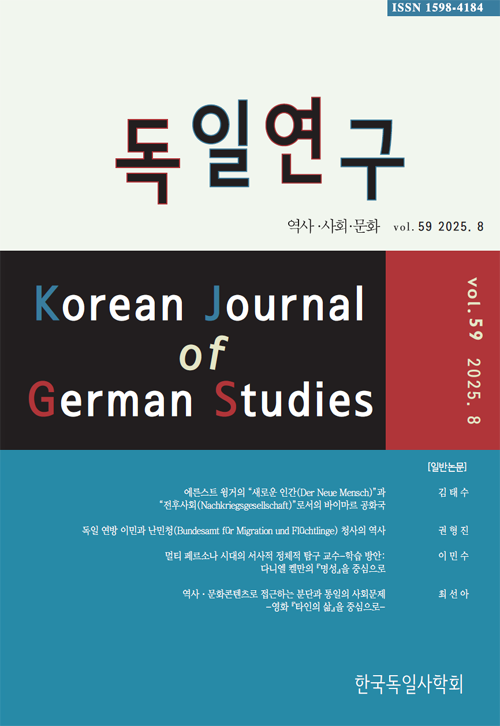- 영문명
- Teaching and Learning Method for Exploring Narrative Identity in the Multi-Persona Era: Focusing on Daniel Kehlmann’s Ruhm
- 발행기관
- 한국독일사학회
- 저자명
- 이민수(Min Su Lee)
- 간행물 정보
- 『독일연구』Vol.59, 87~132쪽, 전체 46쪽
- 주제분류
- 인문학 > 역사학
- 파일형태
- 발행일자
- 2025.08.31
8,320원
구매일시로부터 72시간 이내에 다운로드 가능합니다.
이 학술논문 정보는 (주)교보문고와 각 발행기관 사이에 저작물 이용 계약이 체결된 것으로, 교보문고를 통해 제공되고 있습니다.

국문 초록
본 연구는 현대 미디어 기술의 발전으로 온라인과 오프라인을 넘나들며 다양한 자아를 구성하는 ‘멀티 페르소나 시대’의 현대인의 정체성 혼란 문제를 다룬다. 특히 디지털 네이티브로 성장한 MZ세대의 정체성 위기에 주목하여, 다니엘 켈만의 소설 『명성』을 마중물로 하여 문학 교육적 해법을 제시하는 것을 목적으로 한다.
이론적 토대로는 폴 리쾨르의 삼중 미메시스 이론과 서사적 정체성 개념을 활용하였다. 리쾨르는 인간의 정체성을 고정된 본질이 아닌 시간 속에서 이야기를 통해 끊임없이 재구성되는 ‘서사적 정체성’으로 파악한다. 삼중 미메시스 이론은 미메시스 I(이야기 구성 이전의 행위 세계에 대한 전이해), 미메시스 II(무질서한 사건들을 하나의 이야기로 형상화하는 구성 활동), 미메시스 III(독자가 서사를 통해 자신의 삶을 재해석하는 변환 과정)의 세 단계로 구성된다. 서사적 정체성은 동일성(시간 속 불변 특성)과 변화 속에서 항구적인 자기성(윤리적 주체성)의 이중 구조를 갖는다.
교수-학습 방안은 『명성』의 9개의 이야기 중 현대 미디어 환경에서 개인의 정체성 혼란과 분열을 잘 드러낸 4가지 이야기(「목소리들」, 「탈출구」, 「토론에 글 올리기」, 「내가 어떻게 거짓말을 하면서 죽어 갔는지」)에 집중한다. 우선 「목소리들」의 주인공 에블링의 서사를 삼중 미메시스와 서사적 정체성을 중심으로 분석하고 이를 바탕으로 교수-학습 방안을 제안한다.
교수-학습 방안은 ‘나의 삶(Mimesis I) → 작품 읽기(Mimesis II) → 나의 삶 재해석(Mimesis III)’의 순환적 과정으로 설계된다. 수업 전 단계(미메시스 I)에서는 미디어 환경 속에서 학습자의 멀티 페르소나를 살펴보고 각자의 경험을 공유하는 활동을 진행한다. 수업 중 단계(미메시스 II)에서는 작품 속 인물의 서사적 정체성이 어떻게 형성되었는지를 탐구한다. 수업 후 단계(미메시스 III)에서는 텍스트와 학습자 삶의 지평을 융합하여 학습자의 서사적 정체성과 윤리적 책임에 대한 종합적 성찰을 진행한다.
본 연구는 독일 문학 텍스트와 리쾨르의 서사 철학을 접목하여, 디지털 시대 대학생들의 다중 정체성 문제의 해법의 하나로서 서사적 정체성 교육의 가능성을 구체적으로 제시했다는 점에서 학술적 의의를 지닌다.
영문 초록
This study addresses the issue of identity confusion faced by modern individuals in the ‘multi-persona era,’ where they construct various selves across online and offline spaces due to advancements in digital technology. It particularly focuses on the identity crisis of Generation MZ, who have grown up as digital natives, and aims to propose a literary educational solution centered on Daniel Kehlmann’s novel Fame (Ruhm).
The theoretical foundation of this study is grounded in Paul Ricoeur’s theory of triple mimesis and the concept of narrative identity. Ricoeur perceives human identity not as a fixed essence, but as a “narrative identity” that is continuously reconstructed through stories over time. The theory of triple mimesis consists of three stages: Mimesis I (the prefiguration or pre-understanding of the world of action), Mimesis II (the configuration that shapes disordered events into a unified story), and Mimesis III (the refiguration, a process where readers reinterpret their own lives through the narrative). Furthermore, narrative identity has a dual structure, encompassing both sameness (idem-identity, or unchanging characteristics over time) and selfhood (ipse-identity, or ethical subjectivity).
The teaching and learning Method focuses on four of the nine stories in Fame that vividly reveal an individual’s identity confusion and fragmentation in the modern media environment: “Voices” (“Stimmen”), “The Way Out” (“Der Ausweg”), “A Contribution to the Debate” (“Ein Beitrag zur Debatte”), and “How I Lied and Died” (“Wie ich log und starb”). First, the narrative of Ebling, the protagonist of “Voices”, is analyzed through the lens of triple mimesis and narrative identity. Based on this analysis, a corresponding teaching and learning Method is proposed.
The teaching and learning Method is designed as a cyclical process: My Life (Mimesis I) → Reading the Literary Work (Mimesis II) → Reinterpreting My Life (Mimesis III). Before the lesson (Mimesis I), students will engage in activities to explore their own multiple selves in the context of the modern media environment and share their personal experiences. During the lesson (Mimesis II), the focus shifts to analyzing how the narrative identities of the characters in the novel are constructed. After the lesson (Mimesis III), the process culminates in a comprehensive reflection on the students’ own narrative identities and ethical responsibilities, achieved by fusing the world of the text with their own life experiences.
By integrating German literary texts with Ricoeur’s narrative philosophy, this study makes a significant academic contribution by proposing narrative identity education as a potential solution to the multiple identity challenges of university students in the digital age.
목차
Ⅰ. 들어가는 말
Ⅱ. 이론적 배경
Ⅲ. 『명성』과 서사적 정체성
Ⅳ. 교수-학습 방안
Ⅴ. 나가는 말
참고문헌
키워드
해당간행물 수록 논문
참고문헌
교보eBook 첫 방문을 환영 합니다!

신규가입 혜택 지급이 완료 되었습니다.
바로 사용 가능한 교보e캐시 1,000원 (유효기간 7일)
지금 바로 교보eBook의 다양한 콘텐츠를 이용해 보세요!



